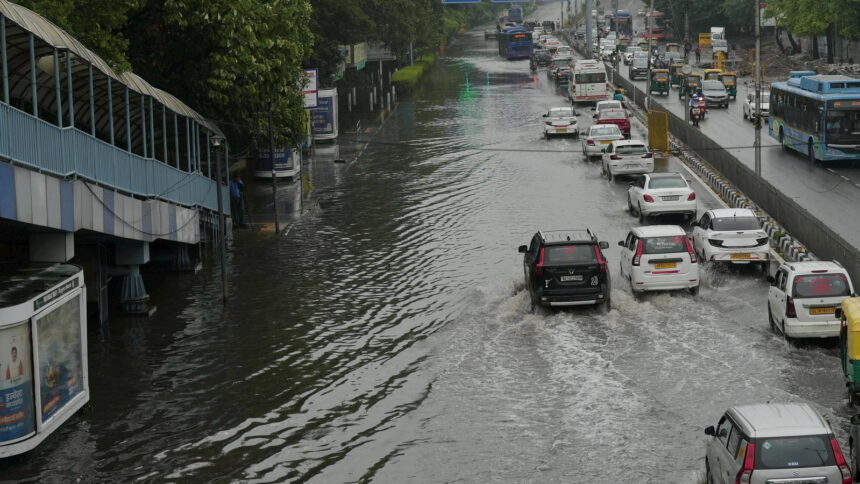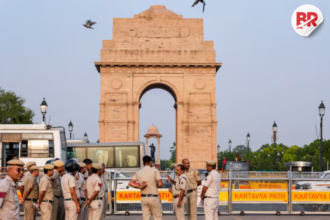
Delhi has officially recorded its wettest May on record, as intense thunderstorms and heavy rainfall on Saturday night caused widespread disruption, from traffic snarls to flight delays. The city’s primary weather station at Safdarjung reported a total of 186.4 mm of rainfall so far this month, nearly nine times the usual monthly average of 21.9 mm. This marks the highest-ever rainfall recorded in May, surpassing the previous record of 165 mm set in 2008.


The heavy downpour and overnight thunderstorm hit with force, leaving roads submerged, trees uprooted, and causing flight disruptions at Indira Gandhi International Airport. The India Meteorological Department (IMD) issued a red alert at around 10:30 pm Saturday, warning of an approaching thunderstorm that would bring severe winds, heavy rainfall, and dangerous lightning to the region.
Thunderstorm Impact and Severe Weather Alerts
According to the IMD, the thunderstorm was accompanied by gusty winds reaching speeds of up to 82 km/h and temperatures dropping sharply by 8 to 10 degrees Celsius in less than 90 minutes. At Safdarjung, temperatures plunged from 31°C to 21°C between 1:15 am and 2:30 am on Sunday. Similar drops were observed across the city, including at Palam and Lodhi Road stations.
The IMD warned of significant disruption, with the severe weather posing risks of uprooted trees, damage to temporary structures, and power line outages. The gusty winds were also expected to cause delays in flight and train services. Authorities urged residents to stay indoors, avoid sheltering under trees or metal structures, and for farmers and workers to cease outdoor activities.

Flooding and Waterlogging Across the City
The city saw significant waterlogging in various areas, including Bhairon Marg, where vehicles were submerged due to the heavy rainfall. The downpour led to water accumulation at several underpasses and major roads, which affected daily commuting for thousands of residents. Some areas in Delhi, such as Safdarjung, Lodhi Road, and Palam, recorded rainfall figures ranging from 68 mm to 81 mm in just 24 hours, adding to the city’s mounting storm-related challenges.

A String of Storms in May: Deaths and Widespread Damage
May has proven to be an extremely volatile month for Delhi’s weather. On May 2, a massive storm dumped 77 mm of rainfall in just 24 hours, marking the second-highest rainfall total for the month. Tragically, four family members lost their lives in Dwarka when their house collapsed during the storm. On May 15, strong winds from Pakistan and northwestern India brought dust and a sharp deterioration in air quality. The city also saw wind gusts of up to 80 km/h on May 21, dropping temperatures by 14°C in just a few hours.
So far, May’s storms have claimed at least 12 lives, with more than 300 trees uprooted across the city. Infrastructure has been heavily damaged, with widespread power outages, blocked roads, and large parts of Delhi affected by waterlogging. The continuous severe weather has left many neighborhoods struggling to cope with the aftermath.

Cause of the Storms: Unusual Weather Systems
The ongoing storms have been fueled by a combination of factors, including easterlies and southeasterlies moisture-laden winds from the Bay of Bengal and southwesterlies from the Arabian Sea. These winds have interacted with mid-level dry westerlies, leading to intense thunderstorms over the region. Several weather systems, including a Western Disturbance over north Punjab and an upper air cyclonic circulation over northwest Uttar Pradesh, have contributed to the unusually heavy rains and violent thunderstorms in Delhi.
A Month of Extreme Weather for Delhi
Delhi’s record-breaking wet May has left the city grappling with the consequences of its extreme weather. The ongoing storms have had a devastating impact on infrastructure, public safety, and the city’s transportation network. As the city moves into the final week of May, residents and authorities will need to remain vigilant as more thunderstorms may be on the horizon. With the season’s severe weather showing no signs of slowing down, it’s clear that Delhi is facing an unprecedented challenge in its weather patterns this year.












